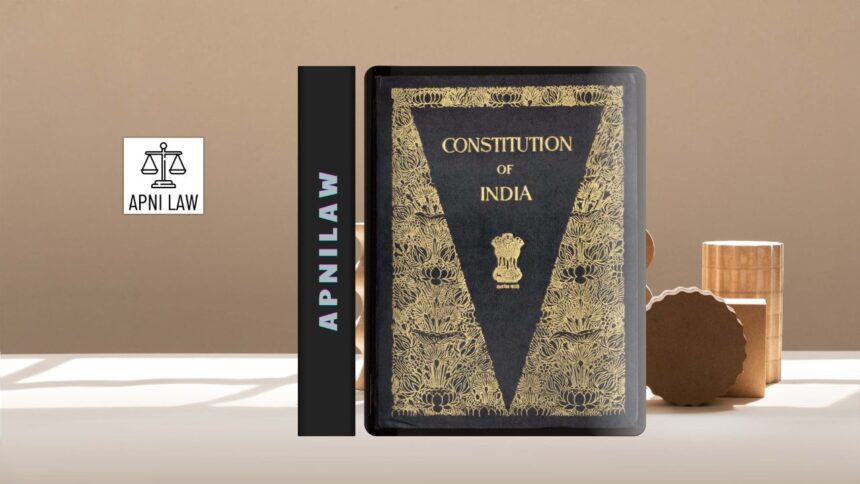The Basic Structure Doctrine stands as one of the most important contributions of the Supreme Court to Indian constitutional law. It declares that while Parliament can amend the Constitution, it cannot alter or destroy its essential framework. These core elements form the backbone of the Constitution and ensure that India’s democracy, freedoms, and principles remain protected against arbitrary power. The doctrine evolved through judicial interpretation, beginning with the landmark Kesavananda Bharati case (1973) and strengthened through later rulings.
What is the idea behind the basic structure doctrine?
The basic structure doctrine emerged as a safeguard against Parliament’s unlimited power to amend the Constitution. Article 368 grants Parliament authority to amend constitutional provisions, but the Supreme Court held that this power is not absolute. The doctrine ensures that the Constitution retains its essential features even when amended to meet changing social or political needs.
The doctrine reflects a balance. On one side, Parliament must have flexibility to adapt the Constitution for development and reform. On the other side, the permanent values of democracy, liberty, equality, and justice cannot be compromised. The basic structure acts like a protective shield that prevents political majorities from dismantling the foundation of the nation.
How did the doctrine originate?
The origin lies in the Kesavananda Bharati v. State of Kerala (1973) case. Swami Kesavananda Bharati challenged Kerala’s land reform laws, but the case soon expanded into a debate about Parliament’s power under Article 368. A 13-judge bench, the largest in Indian history, heard arguments for 68 days.
On April 24, 1973, the Court delivered a 7:6 judgment. It ruled that Parliament could amend the Constitution, including fundamental rights, but it could not damage its basic structure. This ruling created a new constitutional principle. The Court did not define all the elements of the basic structure, but it identified several features that could never be destroyed. Over the years, later judgments clarified and expanded these elements.
Why is the supremacy of the Constitution a basic feature?
The Constitution is the supreme law of the land. Every law, action, and amendment must conform to it. If Parliament could alter its supremacy, then India’s legal system would lose its anchor. The Supreme Court emphasized that constitutional supremacy ensures stability and prevents arbitrary exercise of legislative power. It distinguishes India from systems where Parliament is supreme. By placing the Constitution above all organs of the state, the doctrine secures continuity of governance within a legal framework.
How does sovereignty, democracy, and republicanism form part of the basic structure?
India is a sovereign, democratic, and republican state. Sovereignty means India’s independence from external control. Democracy means the people hold ultimate authority through free elections. Republicanism means the head of the state is elected, not hereditary. These principles reflect the will of the people. The Court held that if Parliament could amend these features, India’s identity as a democratic republic would collapse. Thus, they form the unshakable foundation of governance.
Why is secularism included in the basic structure?
Secularism ensures equal treatment of all religions. The state cannot favor or establish a particular religion. In a diverse country like India, secularism preserves unity and prevents discrimination. The Supreme Court reaffirmed in the S.R. Bommai v. Union of India (1994) case that secularism is part of the basic structure. Any attempt to convert India into a theocratic state would violate the Constitution.
How does separation of powers safeguard democracy?
The Constitution divides power among the legislature, executive, and judiciary. Each branch functions independently but within checks and balances. If Parliament could remove this separation, it could accumulate absolute power. Judicial independence would collapse, and executive overreach would become unchecked. Therefore, the separation of powers is treated as a core element that maintains accountability and prevents authoritarianism.
Why is federalism an essential feature?
India follows a unique model of federalism with a strong center but guaranteed powers for states. The federal character balances unity with diversity. The Court ruled that federalism prevents excessive centralization and respects the rights of states. Any amendment that destroys the distribution of powers between the Union and states would damage the identity of the Constitution.
How does the rule of law protect citizens?
The rule of law ensures that no one is above the law, including the government. Laws must be applied fairly and equally. Arbitrary power has no place under this principle. The Court has consistently protected the rule of law as part of the basic structure because without it, democracy cannot survive. It ensures accountability and maintains faith in justice.
Why are fundamental rights part of the basic structure?
Fundamental rights guarantee individual freedoms against arbitrary state action. They include rights to equality, liberty, freedom of expression, and protection of life. While Parliament can amend rights to balance them with social needs, it cannot abolish them. The Court declared that rights like equality before law and freedom of expression form the essence of the Constitution. Stripping them away would reduce citizens to subjects under state authority, which the Constitution does not permit.
How does judicial review protect the Constitution?
Judicial review allows courts to examine laws and executive actions for constitutionality. Without judicial review, there would be no mechanism to check legislative or executive excess. In Indira Nehru Gandhi v. Raj Narain (1975), the Court struck down a constitutional amendment that excluded judicial review of elections, declaring it part of the basic structure. Judicial review ensures that every act of government conforms to the Constitution.
Why is the unity and integrity of the nation protected?
India’s unity and territorial integrity are central to its survival as a nation. The Constitution emphasizes national unity while recognizing cultural diversity. Any amendment threatening territorial integrity or national unity would destroy India’s existence. Thus, the unity and integrity of the nation is preserved as part of the basic structure.
What role does the welfare state play in the basic structure?
The Constitution directs the state to establish a welfare society based on justice, equality, and dignity. Directive principles guide policies toward social and economic reforms. While they are not enforceable as rights, they shape governance. The Court held that a welfare state is part of the Constitution’s vision, making socio-economic justice an inseparable feature of its identity.
Why is the parliamentary system important?
The parliamentary system ensures government accountability to the legislature. It requires regular, free, and fair elections. Citizens elect representatives who form the government. The Court ruled that Parliament cannot replace this system with an authoritarian model. The parliamentary system guarantees responsible governance and maintains the democratic structure.
Why must the judiciary remain independent?
An independent judiciary ensures impartial justice. If the executive or legislature could control the judiciary, the Constitution’s guarantees would become meaningless. The Court has consistently upheld judicial independence as part of the basic structure. This protects citizens’ rights and sustains public trust in the justice system.
Why is Parliament’s amending power limited?
Parliament’s power to amend the Constitution is wide but not absolute. The Supreme Court made clear that unlimited power would allow Parliament to rewrite the Constitution completely. By limiting this power, the basic structure doctrine ensures that amendments cannot destroy essential principles. This balance preserves both flexibility and stability in constitutional law.
How has judicial interpretation shaped the doctrine?
The Kesavananda Bharati case laid the foundation, but later judgments expanded the doctrine. In Indira Nehru Gandhi v. Raj Narain (1975), the Court applied it to protect free elections. In Minerva Mills v. Union of India (1980), it held that limited amending power itself forms part of the basic structure. In Waman Rao (1981) and I.R. Coelho (2007), it ruled that even laws placed in the Ninth Schedule after 1973 are subject to review.
For any specific query call at +91 – 8569843472
Conclusion
The basic structure of the Indian Constitution consists of permanent features that Parliament cannot alter. These include constitutional supremacy, democracy, secularism, rule of law, federalism, fundamental rights, judicial review, independence of the judiciary, and the unity of the nation. The doctrine ensures that the Constitution adapts to change but never loses its essence.
By safeguarding the core values of democracy and justice, the basic structure doctrine preserves India’s constitutional identity. It prevents authoritarianism, ensures accountability, and maintains stability. The doctrine remains the strongest guardian of India’s constitutional democracy, protecting it for generations to come.







